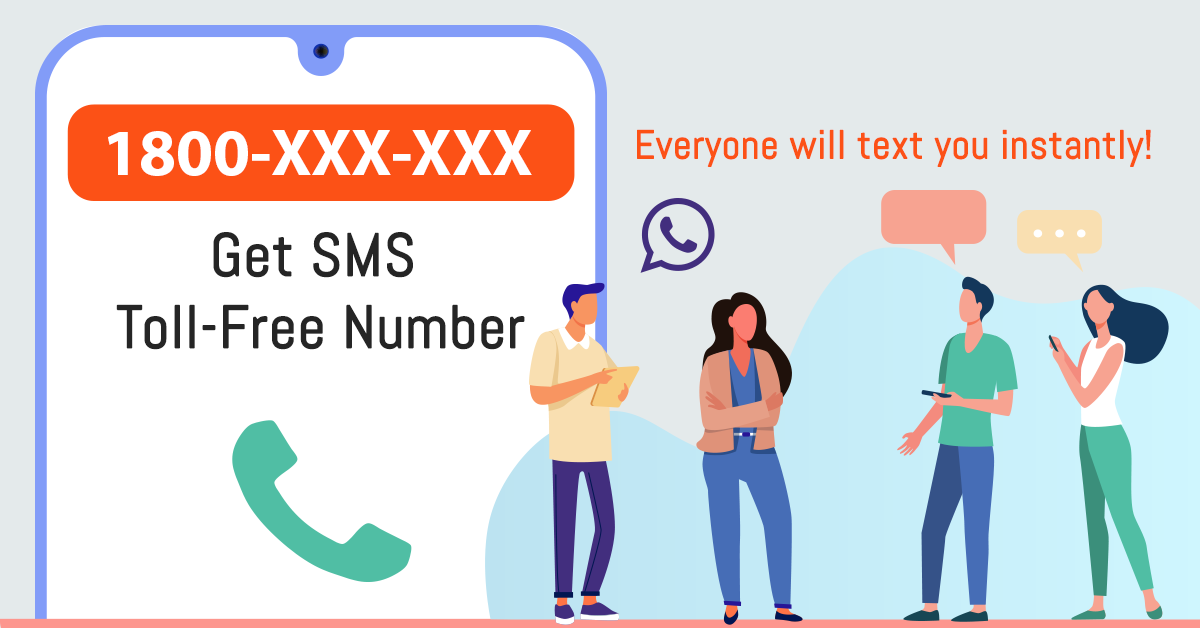What is a Toll-Free Number (TFN) for SMS and MMS Messaging? |
Most people are familiar with toll-free numbers. In the United States, these are mostly recognized as 800 numbers, often used for customer service, government agencies, and other large organizations. However, toll-free numbers are now being used in another way —with text message marketing. For businesses that want to connect with their customers via text message, toll-free numbers can make this simple. In this article, we'll look at the history, benefits, and requirements for using toll-free numbers in mobile marketing.
The History of Toll-Free Numbers
A toll-free number or TFN is any phone number that users can dial without paying, with charges covered by the recipient. TFNs were introduced back in 1967 as an alternative to collect calls.
The most familiar type of toll-free number is 800 but they may also start with the prefixes 888, 877, and others.
Before toll-free numbers, the only way a caller could make a free call was through operator assistance. The system would involve the operator asking the call recipient if they were willing to accept charges. This type of system was workable for personal calls, but not for businesses and organizations that receive hundreds or thousands of calls daily. Toll-free numbers allow for automated calls where the account owner is billed and callers don't need to interact with operators.

Toll-Free Numbers in the Cell Phone Era
800 numbers were widely used over landlines. As much as cell phones and smartphones have changed the world, however, they didn't fundamentally alter how toll-free numbers work. Businesses can now easily get toll-free numbers that can be forwarded to their regular cell number.
Cell phone customers may be less concerned with call charges the way modern phone service plans are structured. The term "long distance call" generally applies to landlines. While cell phone calls made to out-of-state recipients may cost more than local calls, the difference is usually small and absorbed by the customer's monthly plan.
Nonetheless, businesses and organizations still offer toll-free numbers and these may still encourage customers to call. Additionally, people using services such as Skype can call 800 and other toll-free numbers without it affecting their balance. What has changed in recent years, however, is the ability to use toll-free numbers for text messages.
Toll-Free Numbers and SMS Marketing
Text messaging has been around since the 1990s, though it didn't become widespread until the early 2000s as cell phone use became mainstream. When the first iPhone was released in 2007, texting started to take off.
Not surprisingly, businesses wanted to use text messages for marketing. Short message service (SMS) marketing allows a business or organization to set up their own special numbers to better engage with their customers and members. Multimedia message service (MMS) offers more advanced features such as images and videos. Both SMS and MMS services are available with TFNs.
SMS and MMS marketing services have several choices for creating numbers. Although our focus here is on toll-free numbers, it's worth noting the other types of numbers available.
● Short Codes—Short codes are 5 or 6-digit numbers that can be used to send text messages. The advantage is that they are easy to remember. The format for a short code is #12345
● Long Codes —This is a 10-digit phone number that looks like any conventional phone number. Today, the industry is adopting a technology called 10DLC, which allows for high volume messaging. The format for a long code is like any familiar number: #(555)123-4567
● TFN (toll-free numbers) -A TFN is a type of long code that usually have the traditional prefixes such as 800, 888, etc. Customers who already have a toll-free number can often use their existing number for text messages. Toll-free numbers have the format: (800) 123-4567.
Benefits of TFN for Mobile Marketing
Short codes, long codes, and TFNs all have their pros and cons. Most mobile marketing services offer all of them. Here are some of the advantages of a TFN.
● Gives businesses a professional and trustworthy image. Toll-free numbers are associated with established businesses and organizations.
● TFNs have high deliverability rates compared to local numbers.
● A TFN can usually be acquired quickly. Shortcodes take longer to be approved by a carrier.
The Process For Acquiring a TFN
Suppose you want to get a toll-free number for mobile marketing. The following are the steps you need to take.
● Find a provider of mobile marketing services that offer TFNs.
● If you already have a toll-free number, you can get it enabled for texting.
● If you don't have your own TFH, your mobile marketing service can provide you with one.
● TFNs must be verified and approved to ensure compliance with regulations and to prevent carrier filtering.
TFN vs Other Types of Numbers
There are pros and cons to all types of numbers. Here are some factors to keep in mind. Until recently, many businesses used shared short codes to save money. However, these were eliminated in 2021. Dedicated short codes are still an option, but these are costly compared to 10DLC long codes and TFNs.
10DLC long codes are another option, one that lets you use a local phone number.
These are especially good for local businesses that want to emphasize their location.
A TFN, on the other hand, is often the best choice for national (or web-based) businesses that want to reach a high volume of customers at a reasonable cost.
Uses for TFN in Mobile Marketing
The following are some of the ways businesses can leverage a TFN for mobile marketing campaigns.
● SMS Notifications and alerts. Remind customers of appointments.
● Promotional messages. Tell customers about your latest products and services. Promote in-store or online sales.
● Customer support. People are used to calling and receiving calls from toll-free customer service numbers. You can also use TFN for texting customer support.
● Text message polls and surveys. Learn more about your customers. People are more likely to respond to requests from a trusted TFN.
Restrictions For TFNs
A TFN can be used for many purposes, including marketing, customer service, keeping people informed about an organization's events, and much more. However, there are certain restrictions on how you can use a TFN. The following are some purposes that carriers and regulations do not allow for toll-free numbers.
● Speculative, high-risk, or questionable financial offers. This could include investments, multi-level marketing, and work-from-home opportunities.
● Debt collection.
● Controlled or highly regulated industries such as tobacco, firearms, alcohol, and cannabis products (even if they are legal in your state).
● Third-party sales or lead generation. For example, an agency marketing on behalf of other businesses. Only direct marketing is permitted.
Guidelines and Best Practices For Using TFNs for SMS Marketing
The following guidelines apply to all types of mobile marketing. However, they are critical to keeping in mind for TFNs, as these numbers are subject to greater scrutiny and filtering.
● Always obtain opt-in (permission) before texting recipients. Opt-in can be obtained via web forms, email, or other channels as well as text.
● Provide clear instructions for opting out of your list.
● Stay within established guidelines for TFNs (see above list of restrictions).
● When sending links via text, it’s best to use branded and shortened URLs for greater deliverability. However, avoid free URL shorteners (e.g. Tinyurl), which are banned by US carriers.

Toll-Free Numbers: a Powerful Mobile Marketing Tool
As mobile devices get ever more popular, mobile marketing will continue to grow as well. Many other digital marketing strategies, such as email and social media, are getting saturated. Text messages are one of the fastest and best ways to reach any audience, with open rates of 98% (compared to around 20% for email).
A business or other organization that does or is planning to do mobile marketing should research the best type of number to use. For some, a short code or 10DLC may be preferable. Toll-free numbers, however, are ideal for many purposes. Because these numbers are so familiar and trusted, a TFN is a good way to bridge the gap between traditional and mobile marketing, whether a business already has a TFN or they want to acquire a new one.


